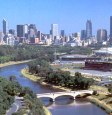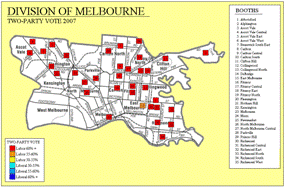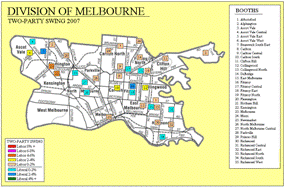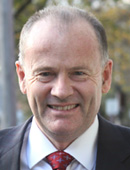
Hon Lindsay Tanner (ALP)
His ministerial
website
and his
electorate website
|  |
Location: Melbourne: Ascot Vale, Carlton, Collingwood, Richmond
Division named for: The City of Melbourne, named in 1837
for Viscount Melbourne, British
Prime Minister
Median weekly family income: $1,176 (24th highest)
Persons born in non English speaking countries: 25.1% (23rd highest)
Persons in professional occupations: 46.5% (9th highest)
Persons employed in tourism: 7.6% (10th highest)
Persons aged 65 and over: 9.7% (115th highest)
Couple families with dependent children: 25.3% (149th highest)
Dwellings being purchased: 16.3% (146th highest)
Dwellings are flat, unit or apartment: 44.5% (6th highest)
Sitting member: Hon Lindsay Tanner
(Labor), elected 1993, 1996, 1998, 2001, 2004, 2007
Born: 24 April 1956, Orbost, Victoria
Career: Solicitor, electorate assistant to Senator Barney Cooney, Victorian state secretary, Federated Clerks' Union.
Member, Opposition Shadow Ministry 1996-2004 and 2005-07. Shadow Minister for Transport 1996-98, Shadow Minister
for Finance 1998-2001, Shadow Minister for Consumer Affairs 1998-2001, Shadow Minister for Communications 2001-04,
Shadow Minister for Community Relationships 2004. Shadow Minister for Finance 2005-07.
Minister for Finance and Deregulation from 3 December 2007
1996 two-party majority: Labor 20.2
1998 two-party majority: Labor 21.8
2001 two-party majority: Labor 20.1
Effect of 2004 redistribution: 00.2 shift to Liberal
2004 two-party majority: Labor 21.1
2007 two-candidate majority: Labor over Green 04.7
2007 notional two-party majority: Labor 22.3

2004 enrolment: 92,176
2007 enrolment: 98,449 (+06.8%)
Melbourne has existed since Federation, its boundaries extending gradually outwards at each successive
redistribution as the inner suburbs have declined (in relative terms) in population, although this trend has
recently been reversed as the CBD has been colonised by wealthy apartment-dwellers. Suburbs like Fitzroy,
Richmond and Collingwood, once slums, are now wealthy areas populated by affluent professionals. Melbourne is now in
the top 20% of seats in terms of median family income and in the top 10% in terms of people
in professional occupations. It also has a high proportion of people born in non English speaking countries.
Conversely, it has very low proportions of families with dependent children and dwellings being purchased.
Labor has held Melbourne continuously since 1904, and the seat is now among the safest Labor seats in terms of
two-party vote. In 2007, however, the Greens came second, and if they could poll more votes than the Liberals and
hold Labor to below 50%, they might win this seat. The problem for the Greens, however, is that they can only win by
gaining Liberal preferences, leaving them open to allegations of a "deal" with the Liberals. Members for Melbourne have
included Arthur Calwell, who was Leader of the Opposition
1960-67. Lindsay Tanner has held the seat since 1993.
Tanner, a leader of Labor's left faction, joined the Opposition front bench in 1996, but resigned after the 2004 defeat.
He returned to the front bench in 2005 and became Minister for Finance in the Rudd government in 2007. At the 2007
election Labor won every booth in two-party terms, polling 83% of the two-party vote at Richmond North and also
topping 80% at Carlton, Collingwood, four booths in Fitzroy, Hotham Hill and Merri. The best Liberal result was
43% at East Melbourne. In two-candidate terms against the Greens, Labor won most booths in the more working-class parts of
the seat by wide margins: 78% at Richmond North, 74% at Hotham Hill, 72% at Ascot Vale. The Greens did best in
areas like Carlton, East Melbourne (56%), Fitzroy and Princes Hill.
|  | |
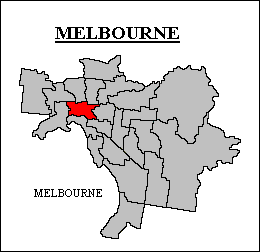
Two-candidate vote by booth, 2007 (Labor vs Green)
 Click to enlarge map
Click to enlarge map
|
